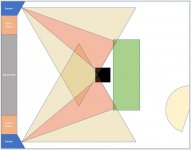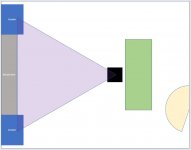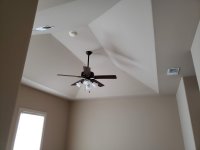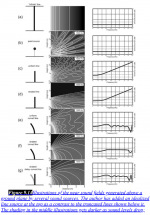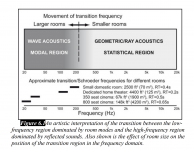Evening All
I have recently closed on a new house that we will be moving into in the next week or so. I have been fortunate enough to have been designated an "office" space so I can move from the current dining room table setup into something a bit more suited for productivity. The challenge is that the room will also double as a "guest room" and triple as my "music room".
I have been looking at the space over the past couple of weeks and have some ideas but wanted to do some gut checking with the community before starting anything as the concept is a bit quirky.
I have a pair of mono-block SET amps based on the 2A3 which are good for about 6.5 amps per side, which I really enjoy and plan to use in the new room.
The room itself is 150" wide and 180" deep. There are a couple of extra alcoves (entryway, bathroom entrance) that increase the space slightly but I am ignoring those for now. The ceiling is 106" at the walls with a raised center.
The basic idea is to install a Murphy bed along the short (150") wall. Alongside the Murphy bed will be some built in cabinets to provide bedside table functionality and extra storage. Outside of that I plan to build some speakers, filling the space to the walls. The Murphy bed assembly is 90" tall.
I initially looked at doing a BIB or other large TL (even toyed with folding the TL over the top of the Murphy bed towards the center of the room, but it all got a bit complex). My major concern with the BIB approach was given how far apart the speakers are (around 135") and how close the drivers would be to the exterior walls, that I would not get a good result at my planned seating position, about 84" from the built in assembly.
Instead I decided to look at a full height sealed box with a large FR driver (thinking AN or Fane). Based on my estimations I could build a box with exterior dimensions of 14.25" wide by 16" deep by 90" tall. Only problem is that wouldn't fit a 15" driver and would still have the wide separation concern. So I considered whether I could angle the front baffle toward the center of the room.
The attached drawing shows speakers with the front baffle angled 30 degrees toward the listener. That makes the front baffle 16.5" wide which should be about enough to get a 15" driver on. In the drawing the black square is my estimate of my seating position beside my work desk (shown in green). The triangles coming out of the speakers show a 10 degree dispersion (in red) and a 30 degree dispersion (in yellow).
Without accounting for internal bracing or driver volume I calculated the internal box volume at about 350 liter (12.5 cubic ft). So good volume to handle even something like the AN Classic 15 Alnico.
But I have not seen anything online with similar geometry (narrow, tall sealed box) and with an angled front baffle, which leads me to believe there is probably a major reason why not.
If anyone has any ideas as to whether this will be a complete disaster, or has a good suggestion as to something else I could do with the space please let me know. Or if anyone has good experience with a BIB stuffed into a corner with a relatively close listening position please let me know. I am totally open to trying something different with this space, and while my diy skills are not the best I think I could have a go at most things. But I honestly have struggled to find much in the way of design ideas for a fully built in solution.
Thanks, Phil
I have recently closed on a new house that we will be moving into in the next week or so. I have been fortunate enough to have been designated an "office" space so I can move from the current dining room table setup into something a bit more suited for productivity. The challenge is that the room will also double as a "guest room" and triple as my "music room".
I have been looking at the space over the past couple of weeks and have some ideas but wanted to do some gut checking with the community before starting anything as the concept is a bit quirky.
I have a pair of mono-block SET amps based on the 2A3 which are good for about 6.5 amps per side, which I really enjoy and plan to use in the new room.
The room itself is 150" wide and 180" deep. There are a couple of extra alcoves (entryway, bathroom entrance) that increase the space slightly but I am ignoring those for now. The ceiling is 106" at the walls with a raised center.
The basic idea is to install a Murphy bed along the short (150") wall. Alongside the Murphy bed will be some built in cabinets to provide bedside table functionality and extra storage. Outside of that I plan to build some speakers, filling the space to the walls. The Murphy bed assembly is 90" tall.
I initially looked at doing a BIB or other large TL (even toyed with folding the TL over the top of the Murphy bed towards the center of the room, but it all got a bit complex). My major concern with the BIB approach was given how far apart the speakers are (around 135") and how close the drivers would be to the exterior walls, that I would not get a good result at my planned seating position, about 84" from the built in assembly.
Instead I decided to look at a full height sealed box with a large FR driver (thinking AN or Fane). Based on my estimations I could build a box with exterior dimensions of 14.25" wide by 16" deep by 90" tall. Only problem is that wouldn't fit a 15" driver and would still have the wide separation concern. So I considered whether I could angle the front baffle toward the center of the room.
The attached drawing shows speakers with the front baffle angled 30 degrees toward the listener. That makes the front baffle 16.5" wide which should be about enough to get a 15" driver on. In the drawing the black square is my estimate of my seating position beside my work desk (shown in green). The triangles coming out of the speakers show a 10 degree dispersion (in red) and a 30 degree dispersion (in yellow).
Without accounting for internal bracing or driver volume I calculated the internal box volume at about 350 liter (12.5 cubic ft). So good volume to handle even something like the AN Classic 15 Alnico.
But I have not seen anything online with similar geometry (narrow, tall sealed box) and with an angled front baffle, which leads me to believe there is probably a major reason why not.
If anyone has any ideas as to whether this will be a complete disaster, or has a good suggestion as to something else I could do with the space please let me know. Or if anyone has good experience with a BIB stuffed into a corner with a relatively close listening position please let me know. I am totally open to trying something different with this space, and while my diy skills are not the best I think I could have a go at most things. But I honestly have struggled to find much in the way of design ideas for a fully built in solution.
Thanks, Phil
Attachments
I had read a few threads about line arrays, and honestly couldn't keep up with the technical aspects.
However since your post I have done a bit more reading and it does seem like the perfect solution for my space.
Guess I need to do some more reading. Thanks for the idea.
However since your post I have done a bit more reading and it does seem like the perfect solution for my space.
Guess I need to do some more reading. Thanks for the idea.
Thanks freddi that's awesome. I'm still struggling to get to grips with hornresp.
As far as driver placement, I would probably prefer to be close to seated ear height, maybe 48 inches from the floor. But having read a few discussions, I would prioritize response if it makes any significant difference, provided the driver does not end up at one extremity or the other.
Good to hear the Fane may be a good fit. It is certainly a much better fit economically.
As far as driver placement, I would probably prefer to be close to seated ear height, maybe 48 inches from the floor. But having read a few discussions, I would prioritize response if it makes any significant difference, provided the driver does not end up at one extremity or the other.
Good to hear the Fane may be a good fit. It is certainly a much better fit economically.
At a glance, the layout appears fundamentally flawed in that we ideally want the speakers, listening position [Lp] to be at a room's odd harmonic [or at least the same major harmonic points] whereas your LP is closer to a null referenced to the [false] sound wall's odd [1st] harmonic, a common mistake that causes all sorts of grief down low and why so many folks are at least initially disappointed with the ~ bottom half of their speaker system's performance.
Stereo wise, as a general rule, need to limit speaker spacing to ~60 deg [included], but can be fine tuned if a well dimensioned [furnished] room space is provided.
Between these two requirements, the LP will likely need to be moved backward somewhat.
GM
Stereo wise, as a general rule, need to limit speaker spacing to ~60 deg [included], but can be fine tuned if a well dimensioned [furnished] room space is provided.
Between these two requirements, the LP will likely need to be moved backward somewhat.
GM
Thanks GM.
Honestly that was what I feared from the start.
The good news is I have spoken to my wife and given that:
a) it saves some money
b) the 90/10 rule falls in my favor (90% of the time the room will be office/music room & 10% of the time the room will be guest room)
c) we really don't need the extra storage
she has agreed we can do away with the built-ins. I can therefore build some big speakers right alongside the Murphy bed, and if I move my desk back just a little bit we can still fit a king size Murphy bed and keep the drivers within the ~60 degree cone.
The problem is that this now opens up a plethora of new options that weren't previously available. My indecisiveness increases.
The diagram attached shows the footprint of a pair of BIBs based on the Seas Exotic X1 (depth and width are flipped from the calculator). Don't think this will work however as the required speaker height is 108" and I only have 106" of ceiling height available.
Also, thinking more about line array option, I'm not sure if my ceiling profile would cause issues. The room has an offset cove ceiling. Not sure if that would potentially create issues with a line array performance. I tried to capture a picture of the ceiling. The Murphy bed/speakers would go against the far wall in the attached.
Anyway, looks like I have a ton of options. I consider myself fortunate to have a space where I can build some speakers where I have a lot of freedom to go big so shouldn't really squander that chance.
But having said that, I don't want to go big for the sake of saying I went big. Overall performance is going to be the deciding factor, so to that end, does anyone have any thoughts or recommendations.
In general I listen to a fairly eclectic range of music, predominantly mainstream from the 60's through the 90's and early 2000's but all genres really. I don't listen at very high levels most of the time but do want to really be able to hear the full range of outputs, and very occasionally stick on a bit of RATM or Daft Punk and blow my ears off. My current speakers are Tekton Design Seas Pendragon. The thing I really enjoy about the current speakers I have is that they sound "lively" even at low volumes. Previous speakers I have owned (B&W in particular) needed to be driven hard to open up and sound "lively".
Anyway, as always really appreciate the information this community provides, especially to someone like me with very little understanding of fundamentals. Any ideas or recommendations greatly appreciated.
Honestly that was what I feared from the start.
The good news is I have spoken to my wife and given that:
a) it saves some money
b) the 90/10 rule falls in my favor (90% of the time the room will be office/music room & 10% of the time the room will be guest room)
c) we really don't need the extra storage
she has agreed we can do away with the built-ins. I can therefore build some big speakers right alongside the Murphy bed, and if I move my desk back just a little bit we can still fit a king size Murphy bed and keep the drivers within the ~60 degree cone.
The problem is that this now opens up a plethora of new options that weren't previously available. My indecisiveness increases.
The diagram attached shows the footprint of a pair of BIBs based on the Seas Exotic X1 (depth and width are flipped from the calculator). Don't think this will work however as the required speaker height is 108" and I only have 106" of ceiling height available.
Also, thinking more about line array option, I'm not sure if my ceiling profile would cause issues. The room has an offset cove ceiling. Not sure if that would potentially create issues with a line array performance. I tried to capture a picture of the ceiling. The Murphy bed/speakers would go against the far wall in the attached.
Anyway, looks like I have a ton of options. I consider myself fortunate to have a space where I can build some speakers where I have a lot of freedom to go big so shouldn't really squander that chance.
But having said that, I don't want to go big for the sake of saying I went big. Overall performance is going to be the deciding factor, so to that end, does anyone have any thoughts or recommendations.
In general I listen to a fairly eclectic range of music, predominantly mainstream from the 60's through the 90's and early 2000's but all genres really. I don't listen at very high levels most of the time but do want to really be able to hear the full range of outputs, and very occasionally stick on a bit of RATM or Daft Punk and blow my ears off. My current speakers are Tekton Design Seas Pendragon. The thing I really enjoy about the current speakers I have is that they sound "lively" even at low volumes. Previous speakers I have owned (B&W in particular) needed to be driven hard to open up and sound "lively".
Anyway, as always really appreciate the information this community provides, especially to someone like me with very little understanding of fundamentals. Any ideas or recommendations greatly appreciated.
Attachments
The thing I really enjoy about the current speakers I have is that they sound "lively" even at low volumes. Previous speakers I have owned (B&W in particular) needed to be driven hard to open up and sound "lively".
From Floyd Toole's Sound Reproduction 3rd edition
Spectral balance is affected by playback sound levels, and so are several other perceptual dimensions: fullness, spaciousness, softness, nearness, and the audibility of distortions and extraneous sounds, according to Gabrielsson et al. (1991). Higher sound levels permit more of the lower-level sounds to be heard. Therefore, in repeated sessions of the same program material, the sound levels must be the same.
That leads me to believe you should get a measurement microphone and software like REW to measure what it is that you like about your speakers. Play them at the volume you like with the soundtrack you like. Then run a sweep using that volume level. Look at the frequency response and see what's going on that makes you like the sound of your current speakers.
REW is free software. A measurement mic like the Dayton Audio UMM-6 is only around $75. You can find more and less expensive microphones.
You will also use the microphone with your new speakers to help you equalize them.
Something you will always fight in a room that size is bass reproduction. From chapter 6.1 of Toole's book:
One Room, Two Sound Fields—The Transition Frequency
The room curves displayed in Chapter 5 show that the right combination
of anechoic measurements can closely anticipate events in typical rooms at
middle and high frequencies, but at low frequencies the curves are lumpy
and irregular. The acoustical explanation is the dominance of relatively
isolated room modes and associated standing waves at low frequencies, and
of a complex collection of overlapping modes and reflected sounds at high
frequencies. As a result, as frequency increases it becomes progressively
less useful to think about regular patterns of standing waves in rooms, but
rather to think in terms of irregular patterns of constructive and destructive
acoustical interference caused by numerous reflections traveling in many
directions.
You will also run into an adjacent-boundary effect influenced by where you locate your speakers. Longer wavelength frequencies reflect off walls and interfere with one another. Floyd Toole discusses the us of a CBT line array to address that problem in small rooms in Chapter 9.5 Array Loudspeakers—Other Ways to Manipulate Boundary Interactions:
In Figure 9.14f, we see that shading the curved line using the Legendre contour yields a set of plots that have two desirable characteristics: a stable sound level at ear level out to 3 m or more from the loudspeaker, and a relatively constant directivity, meaning that it applies over a wide frequency range. This is a good result, and it has been called the Constant Beamwidth Transducer (CBT). This is not merely coping with the floor as an adjacent boundary, a low-frequency concern; it is using the floor reflection to create a sound field that has desirably uniform broadband sound level over a wide range of listening distances.
Curved loudspeakers may not be to everyone’s liking, so applying the
appropriate delays to the individual drivers can, in effect, contour a straight
line. When Legendre shading is applied to the delay-curved line, the
resulting CBT is very similar, as seen in Figure 9.14g.
I think what I would suggest is that you take the speakers you like right now and measure them with a mic + REW. Move the speakers around the room and measure them. Move the mic around the room (your listening position) and measure it. Read Floyd Toole's book ($56 on Amazon) in conjunction with measuring the speakers you like.
One additional purchase you might want to make is a DSP ($150) so you can quickly adjust equalization and save the files so you can go back to them later.
The mic + DSP + REW software + Toole's book will make any speakers you finally choose to build sound much better. It will also make it much easier to build your speakers because you'll have confidence in the direction you want to head.
Attachments
Last edited:
Thanks Bradley, this is really great advice.
I will be honest I have been into this hobby for a while but only very recently discovered the DIY community and started to look into understanding some of the science behind sound production. It is frankly quite shameful how long I went without even thinking about it or trying to understand what was driving my experience beyond the usual "maybe I should try changing out component X and see if that makes things "better"".
I will definitely take your advice and try to do some measurements and get some baseline understanding of what it is I am hearing, and like you said, what it is that I am enjoying about that production. However I am also a believer in the adage you don't know what you don't know, and so would definitely like to learn more about what others like, as it pertains to what can be measured and modeled, to see if there are other opportunities to create a sound that I may prefer even more than my current setup.
I will also admit that until recently I subscribed to the minimal influence to the source signal is the "right" way to reproduce sound "the way the recording engineer intended", but more and more I am realizing that some sort of DSP is not only essential to try and manage the negative influences in my environment, but also to tailor the output to something I enjoy.
Thanks again for your feedback. I am started to get excited about this journey, but definitely seems like I need to take a step back and start with what I know today.
I will be honest I have been into this hobby for a while but only very recently discovered the DIY community and started to look into understanding some of the science behind sound production. It is frankly quite shameful how long I went without even thinking about it or trying to understand what was driving my experience beyond the usual "maybe I should try changing out component X and see if that makes things "better"".
I will definitely take your advice and try to do some measurements and get some baseline understanding of what it is I am hearing, and like you said, what it is that I am enjoying about that production. However I am also a believer in the adage you don't know what you don't know, and so would definitely like to learn more about what others like, as it pertains to what can be measured and modeled, to see if there are other opportunities to create a sound that I may prefer even more than my current setup.
I will also admit that until recently I subscribed to the minimal influence to the source signal is the "right" way to reproduce sound "the way the recording engineer intended", but more and more I am realizing that some sort of DSP is not only essential to try and manage the negative influences in my environment, but also to tailor the output to something I enjoy.
Thanks again for your feedback. I am started to get excited about this journey, but definitely seems like I need to take a step back and start with what I know today.
Floyd Toole gives you the green light on DSP.
It's possible DSP got a bad reputation after companies misused it to do weird stuff.
Chapter 4.6.3 Finding and Fixing Resonances
The fact that loudspeaker transducers are basically minimum-phase
devices means that parametric equalization can be used to address a
resonance in such a device, and by reducing the amplitude, the audibility of
the resonance is reduced, as is the ringing. In technical terms minimumphase systems are “invertible.” This is a powerful argument for
loudspeakers with dedicated electronics, including DSP (digital signal
processing).
It's possible DSP got a bad reputation after companies misused it to do weird stuff.
Chapter 15.3 Stereo—An Important Beginning
Taking a different approach, the “Sonic Hologram” (Carver, 1982), was a
simplified version of binaural crosstalk cancellation in the electronic signal
path, while Polk built it into the SDA-1 loudspeakers. Lexicon’s digitally
implemented “panorama” mode allowed for individual setup adjustments to
cater to different loudspeaker/listener geometries. The goal of all of these
was to expand the soundstage beyond the stereo loudspeakers, potentially
out to ±90°. None was doing anything that was intended by the recording
artists, but all were attempting to reward listeners with a more enveloping
listening experience. A host of digital “hall” and other artificialreverberation effects came along in this period; they came to be known as
“DSP” effects. Most were not very good, and some were laughably bad. All
of these devices and processes existed because listeners found a dominant
direct sound field from two loudspeakers to be insufficiently rewarding.
- Home
- Loudspeakers
- Full Range
- Big Built-in Speakers
